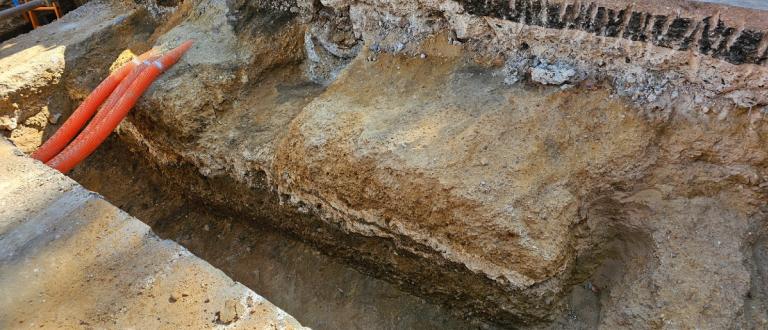
A new energy supply for Southwark’s low carbon heat network will be the latest layer of Old Kent Road’s history following an important section of its Roman past being discovered during excavation works.
Watling Street was built shortly after the Roman invasion of Britain in AD 43.
Roman roads are characteristically straight, so archaeologists had a good idea of where it should be. Yet until now, archaeological evidence had proved very difficult to find in confirming Roman Watling Street’s exact route.
It is the first physical proof that sections of the 2000-year-old route survive directly beneath its modern counterpart Old Kent Road, identified by a team of archaeologists from MOLA (Museum of London Archaeology), working on behalf of Veolia and archaeological consultant RPS, with advice and support from the council’s in-house archaeology officer, Dr Chris Constable.
He said: “I’m pleased this project has answered our questions over the course of the Roman road south of the Cantium Retail Park where a section was excavated in the early 1990s, south of the line of the modern road. In the planning for this project, we’d expected to solve this question but the extent of survival of the road is remarkable. We hope this project will answer some other archaeological questions in the borough.”
Gillian King, director of archaeology at RPS Consulting Ltd, said: “The discovery of an intact section of Roman Watling Street directly under the current Old Kent Road has redrawn the Roman road map for Southwark and informs on Roman construction techniques generally. It is a key finding for archaeological research for London.”
Dave Taylor, MOLA project manager, said: “It’s amazing this section of road has survived for almost 2000 years. There has been so much activity here over the past few hundred years, from sewers to power cables, tramlines and of course the building of the modern road, so we’re really excited to find such a substantial chunk of Roman material remaining.”
The section of Roman road uncovered south of the junction of Old Kent Road and Ilderton Road was well preserved and measures 5.8 metres wide by 1.4 metres high. Distinct layers can be seen, which tell the story of the road’s construction. It has a solid foundation of compacted gravel sealed by two layers of chalk.
This was topped with another layer of compacted sand and gravel. The original surface of the road would likely have been made from the same material and sat at a similar level to the modern road, however this has been lost. The base of the modern road rests directly on the Roman fabric.
Old Kent Road has a vibrant past dating from prehistory to the modern day. Among the most influential literary characters to walk Watling Street were the pilgrims of Chaucer’s Canterbury Tales in the Middle Ages, followed by many notable others, for example: James Bond who drove along it in ‘Moonraker’ and Doctor Who was often depicted here in various regenerations.
The recent discovery was made during early works to bring low carbon heating to 3,000 more council homes along Old Kent Road by Southwark Council and Veolia, with hopes to reduce the borough’s carbon footprint by a further 11,100 tonnes of carbon each year.
Cllr Helen Dennis, cabinet member for new homes and sustainable development, said: “Old Kent Road is one of London’s oldest thoroughfares that embodies much of what makes today’s London special: the diversity, the hubbub, and community spirit. It’s extraordinary to literally be peeling back the layers of Old Kent Road’s history as we work towards a greener future by expanding Southwark’s low carbon heat network.
“I’m excited Southwark is paving the way for future generations by tackling the climate emergency head on. This project to expand the low carbon heat network is absolutely vital to us reducing our reliance on fossil fuels and embracing cleaner, more efficient energy resources. The new insulated pipes also gets us closer to ensuring affordable and reliable heating for the 3,000 additional council homes being connected to the network around Old Kent Road.”
John Abraham, Chief Operating Officer - Industrial, Water & Energy for UK, Ireland and Nordics at Veolia, said: "This new discovery, unearthed during our infrastructure project, gives us a fascinating insight into Roman construction. Whereas the Romans built aqueducts to transport water to cities, Veolia and Southwark Council are utilising a district heating network to provide low carbon heat to homes in the borough. We are delighted to have played a part in this find which is an incredible example of where old meets modern technology!"
The discovery will be marked by a sign on the nearby Old Kent Road bridge, which has undergone its own transformation from old to new with a colourful makeover celebrating the area’s diversity; a bespoke mural titled ‘A Home from Home’ made in collaboration with the local community.
Along a route once used by visiting emperors, today’s Old Kent Road remains a great place to live, work and do business with huge potential to grow. It’s the busiest Opportunity Area in London in respect of new housing. Since 2018, Southwark Council has approved 9,500 homes (an average of 1,500 approvals per year), of which 708 have been completed and 1,825 are currently under construction.
Find out more about the renewal of Old Kent Road at www.oldkentroad.org.uk